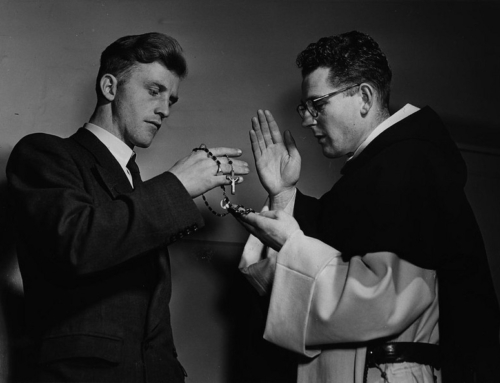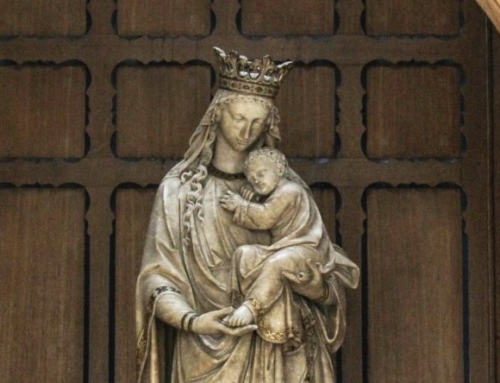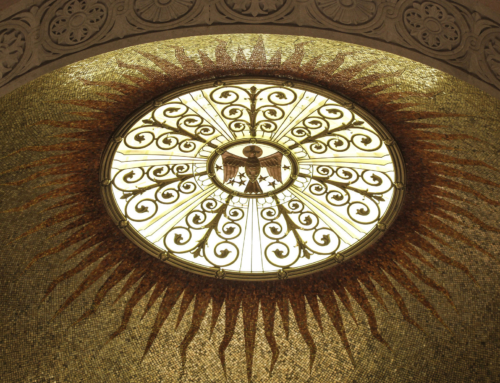An Unlikely (But Significant) Composer of Sacred Music
Throughout his long career, Beethoven rarely composed sacred music—likely for both personal and professional reasons. For one, his early exposure to the faith seems to have lacked substance. Although he was born into a Catholic family and attended a Catholic school for several years, there is little evidence to suggest that his family practiced the faith. The extent of his catechesis is unknown, except that he later recalled being brought up “with proverbs” by a Jesuit teacher (Solomon, “The Quest for Faith,” 216). At the very least, his time as a church organist before the age of ten would have exposed him to the liturgical tradition, if not deeper spiritual realities, as he sought to develop his musical education.
Whatever faint religious impulses Beethoven may have acquired in his early years, his societal context offered no encouragement. The budding composer reached adulthood during the decade of Emperor Joseph II’s Enlightenment reforms, in which religion occupied a role decidedly subordinate to science and reason, and the Church fell victim to the ever-tightening grip of the State. Such a climate was by no means conducive to sacred composition—as a prime example, from 1782 to 1790, veteran composers Mozart and Haydn received no commissions for church music. Even after the death of Joseph II in 1790, Beethoven tended toward the views of enlightened intellectuals, favoring a morally conscious existence but with little regard for the authority of the Church or Christian doctrine.
Despite Beethoven’s disinclination to compose sacred music, and perhaps because of it, the few times he ventured into the realm of sacred music took on special significance. By far the most profound and perplexing instance of this is the Missa Solemnis (“Solemn Mass”), Op. 123, composed in the final decade of his life. Beethoven originally intended the work to honor the elevation of a close friend and patron, Archduke Rudolph, to an archbishopric. Eventually, the Mass took on dimensions of its own and became a highly personal work of enormous scale, requiring longer to complete than any other of his compositions. Beethoven himself highly praised the Missa Solemnis, declaring it to be “the greatest work which I have composed so far” (Solomon, Beethoven, 403). It very likely retained that singular status for the remainder of his life, even after his celebrated Ninth Symphony, which he considered rewriting (Swafford, 857).
Given the tremendous care with which Beethoven composed the Missa Solemnis, and his great affection for it, scholars have struggled to square this monumental religious work with their understanding of him as a person. How could this proponent of the Enlightenment, who largely disavowed orthodox belief, choose to focus his creative efforts so singularly on a Mass setting? To what extent can the Missa Solemnis be seen as a statement of faith? In examining Beethoven’s life and aspects of the composition, an answer to such questions emerges: Beethoven intended the Missa Solemnis both as a statement of personal faith and as the culmination of the Church’s longstanding tradition of faith expressed through music.
A Critical Turning Point
When asked to compose the Missa Solemnis in 1819 for the occasion of his friend’s installation as Archbishop of Olmütz the following year, Beethoven glowingly embraced the task: “The day on which a High Mass composed by me will be performed during the ceremonies solemnized for Your Imperial Highness will be the most glorious day of my life; and God will enlighten me so that my poor talents may contribute to the glorification of that solemn day” (Drabkin, 11). He set aside several other compositional projects, including his Ninth Symphony, in order to devote his full attention to the Mass. Unfortunately, it was not finished in time for the installation—in fact, he did not complete sketches for the Missa Solemnis until late 1822, and he continued to make revisions to the score into the spring of 1823, more than three years after its intended completion date.
Scholars have questioned Beethoven’s motives for taking on the composition of the Missa Solemnis, which lacked the promise of financial compensation. Some have surmised that Beethoven harbored hopes of being appointed kapellmeister (“chapel master”) by the new archbishop as a return of favor for composing it—after all, the position of kapellmeister offered both prestige and financial security. However, this explanation fails to account for the fact that Beethoven missed the deadline for completing the Mass by several years, as well as the fact that the finished composition was so massive in scale that it precluded performance in the liturgy. Even if Beethoven held designs of becoming kapellmeister, such an ambition would contradict the typical depiction of him as an enlightened secular humanist, likely to abhor any role involving the composition of sacred works for a prominent Church hierarch. On the contrary, just a few years prior to beginning composition of the Mass, Beethoven had expressed the desire in his tagebuch, or diary, to compose for a “small chapel” and to dedicate his works to “the glory of the Almighty, the eternal” (Solomon, “The Quest for Faith,” 223).
Whatever Beethoven’s initial motivations were, they must have evolved as the Missa Solemnis grew in scale to the extent that it could no longer fulfill its originally stated purpose. One clue to Beethoven’s inspiration comes from a letter to his colleague Johann Andreas Streicher from September 1824, in which Beethoven offers a retrospective glance at the work: “My chief aim when I was composing this grand Mass was to awaken and permanently instill religious feelings not only into the singers but also into the listeners” (Solomon, Beethoven, 401). This supports the idea that Beethoven did not compose the Missa Solemnis merely to impress an important ally or to attain a position, but more fundamentally as a means of religious expression, even of evangelization.
Making sense of this account of the composer as a promoter of “religious feelings” requires a reexamination of Beethoven’s life and context. Such an undertaking provides evidence that, though he was an Enlightenment enthusiast, Beethoven found the ideals of the Enlightenment insufficient in times of personal crisis. In such instances, rather, religious fervor rose to the foreground in both his personal correspondence and musical output.
The first example of such a crisis occurred with the emergence of Beethoven’s deafness. In April of 1802, he wrote his famous “Heiligenstadt Testament,” addressed to his two brothers, which conveys with great emotion his realization that his hearing was not improving and his deafness would likely be permanent. In the document, Beethoven appeals with a heartfelt plea to God’s omniscience and omnipotence. Not long after, he composed his first significant religious work, the oratorio Christus am Ölberge (“Christ on the Mount of Olives”), along with several songs set to religious texts. Beethoven was dissatisfied with Christus am Ölberge, however, citing primarily the weakness of the text. Nonetheless, he eventually emerged from this crisis with a new, “heroic” style of composition, exemplified by the Eroica Symphony, but his religious impulse seems to have abated.
More than ten years later, a fraught custody battle over his nephew Karl, which stretched from 1815 to 1820, revealed an increasing disposition to sudden rages and paranoia, along with a decline in physical health. The conflict arose because Beethoven’s deceased brother had granted him co-guardianship of Karl in his will, with the expectation that the boy would continue to live with his mother Johanna and benefit from Beethoven’s close involvement. However, Beethoven strongly objected to Johanna’s character, including her history of marital infidelity and embezzlement, and ardently sought sole custody of the boy in what became a legal tug-of-war (Swafford, 660). At this time more than any other, Beethoven expressed the need to come to terms with God. Perhaps it is no coincidence that, in these same years following the end of the Napoleonic Wars, Vienna experienced a religious revival that partially restored Catholicism as a force among intellectual elites. The views of Bishop Johann Michael Sailor, a leading figure of a sentimental form of Catholic Fideism, may have interested Beethoven somewhat, but there is no strong evidence that he adhered to any particular theological school.
Before the crisis over the custody of his nephew Karl subsided, Beethoven learned of his friend’s election as archbishop and eagerly agreed to compose the Missa Solemnis. As with the crisis involving his emerging deafness, this latter crisis would also cause a major shift in Beethoven’s compositional style. Music critic Paul Bekker went so far as to parallel the Missa Solemnis with the Eroica Symphony. In the Eroica Symphony, Beethoven sought to come to terms with his developing deafness; in the Missa Solemnis, he sought to come to terms with God. Accordingly, in the Mass—and his other late works as well—Beethoven’s style moved away from the heroism of his middle period and was transformed and raised to the heights of the spiritual realm (Bekker, 270).
Respect for Textual Meaning and Traditional Musical Forms
Beethoven applied this transformed, spiritual approach in two important ways in the Missa Solemnis: in his concern for shaping the music around the precise meaning of the text, and in his use of centuries-old traditions within sacred music to form new musical ideas. Beethoven struck a balance between maintaining Church tradition in matters of faith and musical expression and applying his creative talents to cast new light on the Mass.
Ample evidence indicates that Beethoven went to great pains to understand the text of the Mass before setting out to compose his Missa Solemnis. He first copied out the entire text in Latin, then carefully translated it line-for-line into German, adding numerous annotations to capture subtle nuances. This preliminary study would serve an especially important purpose, since the text is the true and essential starting point for any discussion of form in the Missa Solemnis. The text of the Mass explains, for instance, the tripartite structure of the Kyrie, the diffuse layout of the Gloria and Credo, and the fact that the Sanctus and Agnus Dei each begin and end in different keys (Drabkin, 19). Such a text-form relationship contrasts strongly with typical approaches to Mass composition in the late eighteenth century, which were largely predetermined by the conventions of instrumental music—such as sonata form and symphonic scoring—and were less of a response to the text itself.
In his preparations for the Missa Solemnis, Beethoven also studied sacred music composition going back centuries, combing through the libraries of Archduke Rudolph and Prince Lobkowitz in search of scores and treatises. Among the composers he examined extensively were Mozart, Haydn, Handel, Bach, and Palestrina. He also studied Gregorian chant and the various church modes, the systems of pitch organization traditionally used in chant, such as Dorian, Lydian, and Mixolydian. His inspiration for doing so can be found in a statement from years earlier: “In the old church modes the devotion is divine . . . and God permit me to express it someday” (Kirkendale, 174). Beethoven’s uncovering of older traditions allowed him to take conventional patterns of musical rhetoric and to reshape them into a more complex musical matrix, affording the Mass an immense expressive power.
To analyze in any depth the Missa Solemnis in terms of the approaches to composition discussed above is beyond the scope of this article. Perhaps an example, however, will suffice to convey the rare beauty and expressive power of the work. In the Credo, Beethoven depicts the mystery of the Incarnation with an enigmatic, complex musical vocabulary. The statement, Et incarnatus est de Spiritu Sancto ex Maria Virgine (“And by the Holy Spirit was incarnate of the Virgin Mary”), is rendered with a chant-like melody in Dorian mode—the mode historically associated with chastity—perhaps intended to convey Mary’s virginal purity (Kirkendale, 175). This melody, other-worldly and tender, is repeated in luscious harmony by a quartet of vocalists, while a flute plays bird sounds, thought to represent the Holy Spirit as a dove. The tenor then heralds the Word made flesh, Et homo factus est (“And was made man”), with an emphatic, heart-rending statement in D Major, thus bringing the focus back to earth.
The Missa Solemnis as a Statement of Faith
This discussion of Beethoven’s life and the Missa Solemnis itself provides ample evidence to support the twofold claim that the composer intended his work as a sincere statement of personal faith and as a creative synthesis of the Church’s tradition of sacred music. Beethoven studied extensively the meaning of the text of the Mass and formed the music around it, drawing upon older musical traditions and rendering them anew in the context of a newly developed, highly spiritual compositional style. Without a doubt, Beethoven has left a true masterpiece—perhaps his greatest work of all—for “the glory of the Almighty, the eternal.”
Recommended Listening
Beethoven, Ludwig van. Missa Solemnis, Op. 123. Performed by Orchestre des Champs Elysées. Conducted by Philippe Herreweghe. Harmonia Mundi, 2010. CD.
For Further Reading
Bekker, Paul. Beethoven. Translated by M.M. Bozman. London: J.M. Dent and Sons, 1925.
Drabkin, William. Beethoven: Missa Solemnis. New York: Cambridge University Press, 1991.
Kirkendale, Warren. “New Roads to Old Ideas in Beethoven’s Missa Solemnis.” In The Creative World of Beethoven, edited by Paul Henry Lang. New York: W. W. Norton and Company, 1970.
Solomon, Maynard. “The Quest for Faith.” In Beethoven Essays. Cambridge, MA: Harvard University Press, 1988.
———. Beethoven. New York: Schirmer Books, 1998.
Swafford, Jan. Beethoven: Anguish and Triumph. New York: Houghton Mifflin Harcourt, 2014.
✠
Download a PDF of this article here.



